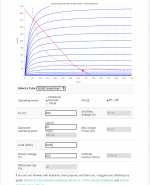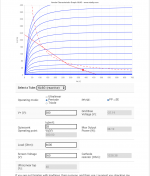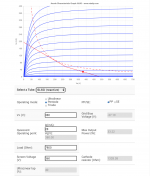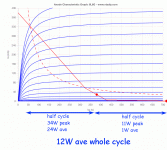I've been repairing an old Ampeg M15 - found a blown OT. I was told on the forum that any 6L6 push pull OT transformer would do and to pick an OT from similar wattage (30w) Fender circuit - so I did. Hammond sells a 4k OT for similar amps like a Vibrolux. ( Follow up conversations claimed that from the OT213 model number, the evidence points to a 6.6k OT. ) Sounds pretty darn good BUT, I ran the VTLADYI load line calculator and it implies that I exceed the max dissipation by a lot.
From the schematic pasted on the amp:
Vb+=390
Vscreen=360
Vbias =34V
Rcath = 250
I've attached screenshots at various OT impedance values and only the highest, around 7.8k falls within safe operation according to the calculator.
My questions are:
1) Will running at 4K damage the tubes (these are metal cans, not glass) - or do guitar amps ignore that curve?
2) The calculated cathode resistor, around 1.5K is well above the actual circuit of 250 ohms
3) Why is there such a variation in 6L6 OT's?
From the schematic pasted on the amp:
Vb+=390
Vscreen=360
Vbias =34V
Rcath = 250
I've attached screenshots at various OT impedance values and only the highest, around 7.8k falls within safe operation according to the calculator.
My questions are:
1) Will running at 4K damage the tubes (these are metal cans, not glass) - or do guitar amps ignore that curve?
2) The calculated cathode resistor, around 1.5K is well above the actual circuit of 250 ohms
3) Why is there such a variation in 6L6 OT's?
Attachments
3) Why is there such a variation in 6L6 OT's?
The lower the voltage the lower the impedance needed to make the maximum power.
Are the tubes redplating? I think 6600 would be a better choice. Maybe the voltage sags under load, although that doesn't sound like Ampeg much.
Last edited:
The classic ratings are "averaged over complete cycle of speech or music"
Your plots only show a half cycle. The hot half. The other half is much less dissipation. The average over the whole cycle is fine.
BTW: the Worst Case will be at 1/3rd to 3/4 of Full Power, where tube still has significant voltage across it even at peak.
> any 6L6 push pull OT transformer would do ...... Rcath = 250
There's different ways to work a pair of tubes and "any OT" does not sound a good guide.
Specifically: with Self Bias (cathode resistor) you generally should be using a higher load impedance so you do not have a large shift of bias from idle to full roar (or cook the tubes at idle). At 390V with any of the 25W tubes and 250r cathode bias, 6.6k loading works quite well. Current and bias shifts very little. But load in 4k and at full roar the current increases, bias shifts from 34V to maybe 44V, there is a burp in the signal as bias shifts.
> The calculated cathode resistor, around 1.5K is well above the actual circuit of 250 ohms
Because it is trying to force the absurdly low (for self-bias) 28mA idle point.
Your plots only show a half cycle. The hot half. The other half is much less dissipation. The average over the whole cycle is fine.
BTW: the Worst Case will be at 1/3rd to 3/4 of Full Power, where tube still has significant voltage across it even at peak.
> any 6L6 push pull OT transformer would do ...... Rcath = 250
There's different ways to work a pair of tubes and "any OT" does not sound a good guide.
Specifically: with Self Bias (cathode resistor) you generally should be using a higher load impedance so you do not have a large shift of bias from idle to full roar (or cook the tubes at idle). At 390V with any of the 25W tubes and 250r cathode bias, 6.6k loading works quite well. Current and bias shifts very little. But load in 4k and at full roar the current increases, bias shifts from 34V to maybe 44V, there is a burp in the signal as bias shifts.
> The calculated cathode resistor, around 1.5K is well above the actual circuit of 250 ohms
Because it is trying to force the absurdly low (for self-bias) 28mA idle point.
Attachments
I see - the max dissipation is more restrictive for a class A where the tube never shuts off.
I can see that for mid signal levels the tube would operate more above the max dissipation curve than for larger signals. So play loud to cool the tube ??? Seems counter intuitive but..
So the voltage divider between the OT and cathode resistor leads to a smaller shift in grid bias voltage if the OT has higher impedance.
If the bias shifts so the anode voltage relative to the cathode becomes less, does this shift the load line to lower anode voltages? Seems like this would snuff the amplitude of the output.
Not sure tonally how the "burp" would sound.
As a test, I doubled the output impedance from 8 ohm to 16ohm with a Weber adjustable matching transformer between the OT and the 8 ohm speaker. I assume the tubes would now see 8K impedance instead of 4k. Tone seemed a bit thinner and lower volume.
I can see that for mid signal levels the tube would operate more above the max dissipation curve than for larger signals. So play loud to cool the tube ??? Seems counter intuitive but..
So the voltage divider between the OT and cathode resistor leads to a smaller shift in grid bias voltage if the OT has higher impedance.
If the bias shifts so the anode voltage relative to the cathode becomes less, does this shift the load line to lower anode voltages? Seems like this would snuff the amplitude of the output.
Not sure tonally how the "burp" would sound.
As a test, I doubled the output impedance from 8 ohm to 16ohm with a Weber adjustable matching transformer between the OT and the 8 ohm speaker. I assume the tubes would now see 8K impedance instead of 4k. Tone seemed a bit thinner and lower volume.
Last edited:
> play loud to cool the tube ??? Seems counter intuitive but..
This was brought home to me when I abused an SE 6550 on dummy-load. Very mature (knocked-around) 6550. Idled 39 Watts of heat. When I brought the output to 17 Watts, the input rose insignificantly (40W) so the plate heat dropped from 39W to 23W. And the tube creaked as it cooled down. (Both meter-math and thermo-readings confirmed it cooled.)
This was brought home to me when I abused an SE 6550 on dummy-load. Very mature (knocked-around) 6550. Idled 39 Watts of heat. When I brought the output to 17 Watts, the input rose insignificantly (40W) so the plate heat dropped from 39W to 23W. And the tube creaked as it cooled down. (Both meter-math and thermo-readings confirmed it cooled.)
I wonder if there is a rule of thumb for the percentage of the signal exceeding the threshold curve shown on the characteristics plot. Given the cost of NOS tubes nowadays, they aren't as expendable as they were in the 60's when they still had tube testers in hardware stores.
For my Ampeg M-15 I bit the bullet and purchased the right replacement OT Hammond 30w at 6600K $110 :-( rather than the 4K replacement I tried to use. More massive than the original OT but works like a charm.
An externally hosted image should be here but it was not working when we last tested it.
Hi
The M15 is like any other cathode biased amp - it is NOT class-A, just cathode biased. Most such amps draw more than the idle current at full output, and that means they have transitioned to class-B.
Those old metal can 6L6s are rated for about 19W plate dissipation. At the 390V supply minus 34V across Rk, leaves 356V. Rk supplies two tubes, so then there is potential for 38W at 356V and 1056mA idle current. However, 34V / 250R = 136mA. Chock up the difference to screen current.
If the amp were to stay class-A, then the peak audio current cannot exceed the idle current total. Limiting class-A is the exact point where one tube is about to turn off. That means 106mA peak through one side of the OT at about 273V peak and and only 29W peak audio. The OT impedance works out to 10k3-aa in this example.
But...most cathode biased amps have the bypass cap across Rk, which allows currents in excess of the idle value to bypass Rk and the idle point stays the same. In an AC-30 rated at 30W, class transition occurs at 22W. The M15 might only be rated for 15W in which case it may stay close to class-A for the full rating.
With the 6k6-aa OT, 106mA would produce only 18W peak at 175V swing. At the full available swing (typically 70% of B+ in a cathode biased amp) peak current would 165mA at 273V and then 45W peak. is this possible with the amp? You would have to measure the output power into a rated load (not a speaker) to see what the reality is.
One reality is that the range of OT values that any given tube can work into is extremely wide; there is more overlap between large bottle tube workable load values than difference. There will be an optimum load for a given supply voltage and PT.
The numbers above are peak. Tube ratings are continuous, or average, so the 45Wpk is 22W average. The 19W rating for the tube is average. over an audio cycle its instantaneous power could be zero or twice the rating - as long as it averages to its rating or less then the tube is happy. The power rating for the tube has little to do with how much audio power it might produce except that the dissipation (heat) off the plate must never exceed the rating on an average basis.
With the 390V supply, assuming it stays steady, the 6l6 load on its own requires a tube rating of 16W avg for the whole output stage - only 8W per tube. A 4k OT would be right at the 38W limit for two tubes, so 19W each. The 4k would be safe for the tubes but the PT may not be able to support it fully.
Paul - in post 10 the link does not load and there is no way to cancel the request.
The M15 is like any other cathode biased amp - it is NOT class-A, just cathode biased. Most such amps draw more than the idle current at full output, and that means they have transitioned to class-B.
Those old metal can 6L6s are rated for about 19W plate dissipation. At the 390V supply minus 34V across Rk, leaves 356V. Rk supplies two tubes, so then there is potential for 38W at 356V and 1056mA idle current. However, 34V / 250R = 136mA. Chock up the difference to screen current.
If the amp were to stay class-A, then the peak audio current cannot exceed the idle current total. Limiting class-A is the exact point where one tube is about to turn off. That means 106mA peak through one side of the OT at about 273V peak and and only 29W peak audio. The OT impedance works out to 10k3-aa in this example.
But...most cathode biased amps have the bypass cap across Rk, which allows currents in excess of the idle value to bypass Rk and the idle point stays the same. In an AC-30 rated at 30W, class transition occurs at 22W. The M15 might only be rated for 15W in which case it may stay close to class-A for the full rating.
With the 6k6-aa OT, 106mA would produce only 18W peak at 175V swing. At the full available swing (typically 70% of B+ in a cathode biased amp) peak current would 165mA at 273V and then 45W peak. is this possible with the amp? You would have to measure the output power into a rated load (not a speaker) to see what the reality is.
One reality is that the range of OT values that any given tube can work into is extremely wide; there is more overlap between large bottle tube workable load values than difference. There will be an optimum load for a given supply voltage and PT.
The numbers above are peak. Tube ratings are continuous, or average, so the 45Wpk is 22W average. The 19W rating for the tube is average. over an audio cycle its instantaneous power could be zero or twice the rating - as long as it averages to its rating or less then the tube is happy. The power rating for the tube has little to do with how much audio power it might produce except that the dissipation (heat) off the plate must never exceed the rating on an average basis.
With the 390V supply, assuming it stays steady, the 6l6 load on its own requires a tube rating of 16W avg for the whole output stage - only 8W per tube. A 4k OT would be right at the 38W limit for two tubes, so 19W each. The 4k would be safe for the tubes but the PT may not be able to support it fully.
Paul - in post 10 the link does not load and there is no way to cancel the request.
....Paul - in post 10 the link does not load and there is no way to cancel the request.
Do NOT click on this forum's "Click the image to open in full size." links. That never works. The right answer is for the poster to use this forum's Attach function, so all linkage is in one place. But in the meantime, try RIGHT-clicking the "Click the image to open in full size" link and "Open in New Tab". This works about 99% of the time.
- Status
- This old topic is closed. If you want to reopen this topic, contact a moderator using the "Report Post" button.
- Home
- Live Sound
- Instruments and Amps
- How much can one exceed max dissipation?



